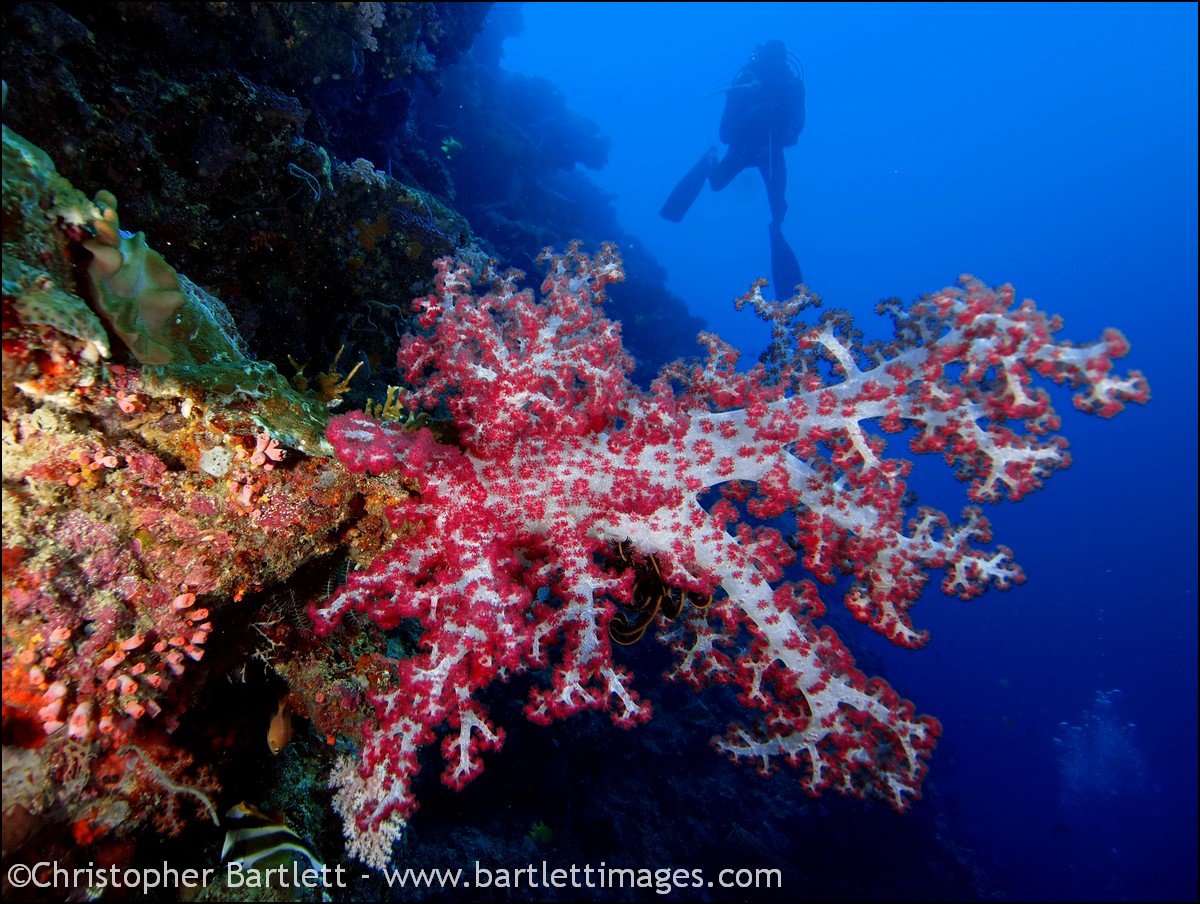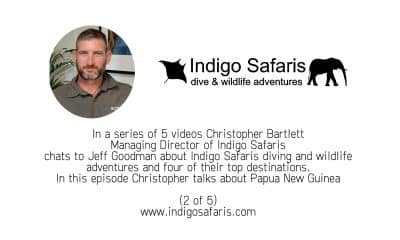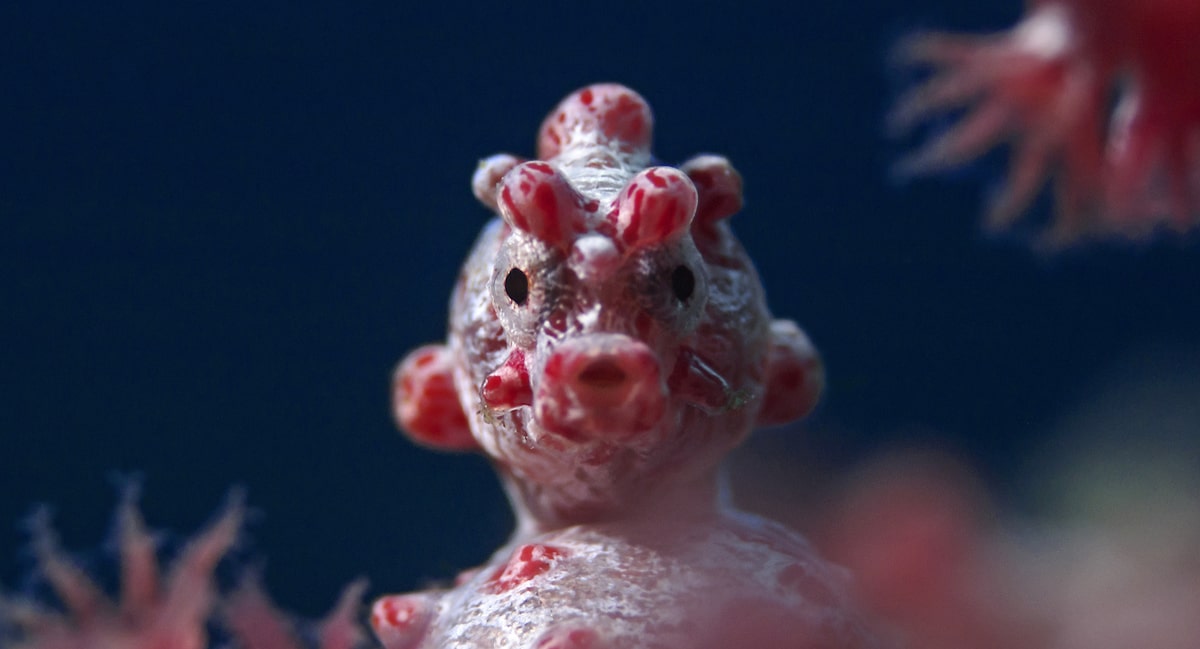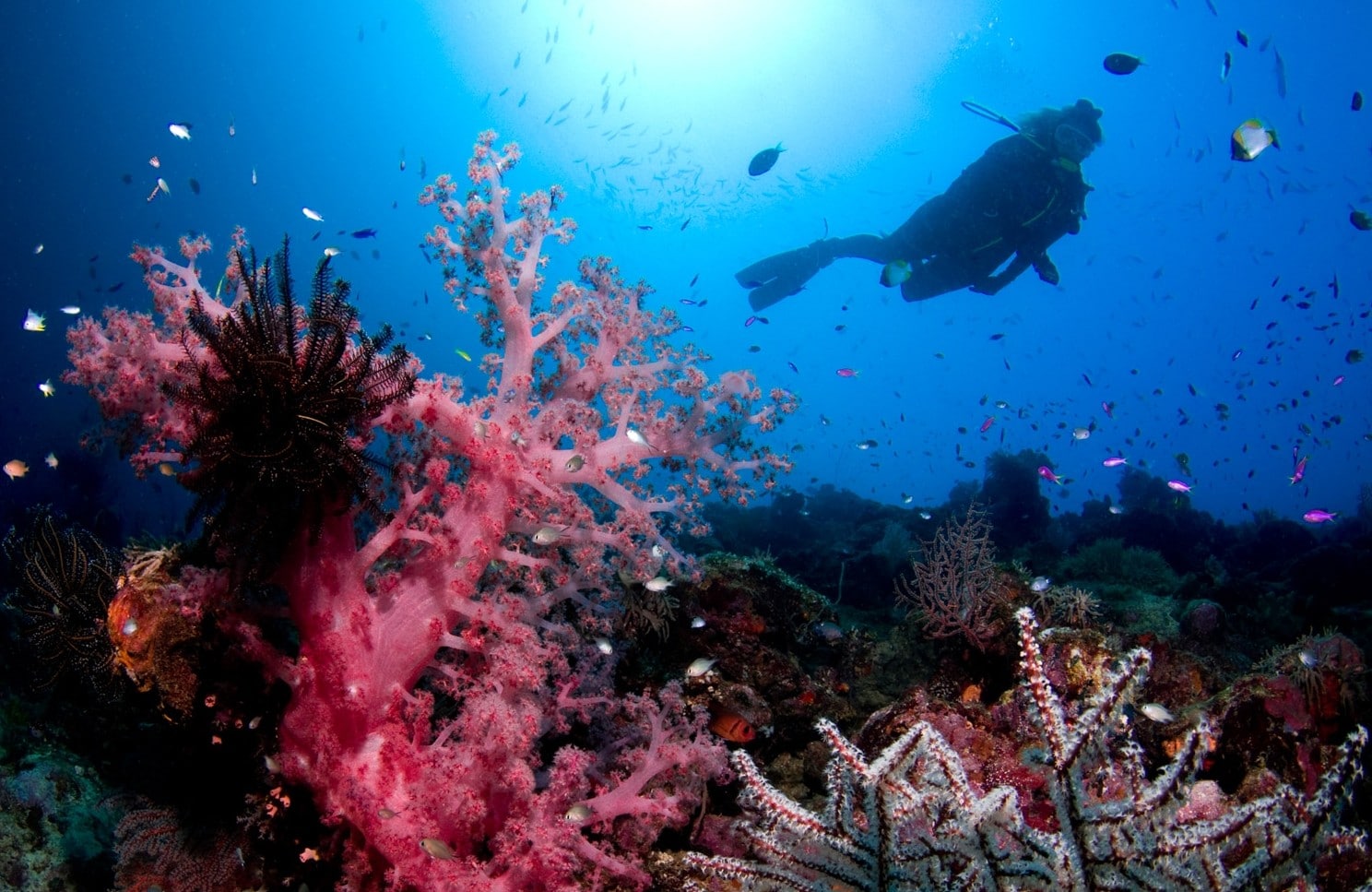Travel Stories
In love with (a bommy called) Suzy

Is it possible to fall in love with a dive site? Christopher Bartlett visits Loloata Island Resort in Papua New Guinea to find out
She’s bright and colourful on surface, but deep and complex the more you get to know her. Her charms are numerous and sometimes mysterious, yet she’s always easy-going and welcoming.
If she sounds like the ideal girl, it’s because she is – almost. Suzy is in fact a bommy and a dive site on the barrier reef outside Bootless Bay, Port Moresby.
I’d heard of Suzy’s charms over dinners in Paris, lunches in London, and coffee in Madrid. The few aficionados of adventure and connoisseurs of coral who’d witnessed her beauty recalled their encounters with misty, wistful eyes. I promised to myself that on my next visit to PNG I would check her out.
Sometimes legends are created from little substance, exaggerations creep in, embellishments are made. To top it off, I would be spending my 40th birthday at Loloata Island Resort. Festive expectations are often raised, anticipation runs high, and then the party goes off with a pfffft rather than a resounding pop. Would Suzy be the same?
My party plans weren’t in synch with the dive plan (although I was more than happy to just be getting back into PNG waters again). A group was in and had requested morning dives at Pumpkin Patch and Dinah’s Delight with a post-prandial potter around Lion Island. Being my first dive in five months, I missed part of Pumpkin Patch readjusting my kit, getting used to my new BCD, tuning back in with the water and my camera. I did see the Pygmy seahorse, the crocodile fish, and an olive sea snake, though with a not inconsiderable current my photos were never going to be keepers.
Dinah’s Delight, named after the wife of PNG diving pioneer Bob Halstead, was true to its name. The gorgonian fan-filled gullies were gorgeous and harboured my first ever sighting of a tasselled wobbegong shark, it’s mottled camouflage not evading the eye of our dive guide, Roy. It was an unexpected birthday treat, and I marvelled at the elaborated fronds protruding from below its bottom lip. Within the mass of tassels are branched nasal barbels and grooves that channel surrounding water to the shark’s mouth. The barbels are perfectly positioned to help these bottom-dwelling sharks detect a variety of bottom-dwelling prey such as crabs, lobsters, cephalopods, echinoderms and fishes. Wobbegongs have even been documented eating bamboo sharks of a length similar to their own. Although believed to be a rare occurrence, with a jaw structure that facilitates dislocation, a large gape, and sharp, rearward-pointing teeth, wobbegongs can grasp a relatively large prey before swallowing it whole.
[wppa type=”slideonlyf” album=”6″ size=”auto” align=”center”][/wppa]
After a lobster-tail lunch back at Loloata we departed for nearby Lion Island. The island is the location of a couple of deliberately sunken fishing trawlers that host some interesting fish life, and a shallow sandy slope interspersed with patches of seagrass that hide a host of small and interesting critters. A spinecheek anemonefish posed for a birthday photo, a porcelain crab modelled perfectly for me, a luridly coloured peacock mantis shrimp poked its bright blue eyes out of its tunnel in the sand, and a shrimp bearing eggs that I had never seen before (that turned out to be a Holthuis’ shrimp) hopped around the tentacles of her host anemone. All in all, I didn’t feel like I’d missed anything at all and was most content with the underwater birthday bounty I had received.
The next morning Roy and Raga gave us our daily diving menu: End Bommy, Suzy’s Bommy, and the wreck of the MV New Marine. Three nautical miles out to sea on the outer barrier reef, End Bommy’s abundant life is fed by the tides that bring nutrients around and over it. After mooring on a pin on the main reef, we started finning across 40 metres of blue water. Before I was halfway across, I could make out the wall opposite me. It was certainly well-nourished; with gorgonian fans, pink sea whips, tubastraea and soft coral trees perched on its sides. The tide hadn’t quite started to go out, but there were still plenty of fish. Crinoids, also called feather stars, hung off gorgonians and sea whips with their limbs extended, feeding on plankton in the gentle current. The colours were beautiful.
On the way back I started sorting through the 100-odd images I’d taken, thinking that we were done, Raga led us off on a short diversion. We’d already been down for 60 minutes, so it had to be something good. And it was. The largest congregation of bubble-tip anemones I have ever seen, playing host to over a hundred dusky anemonefish. Incredible.
How was Suzy’s going to beat that? An hour later the outgoing tide was in full flow, pulling nutrients from the inshore waters out to the deep, and pulling in a lot of hungry fish. Big schools of deep-bodied and twin-striped fusiliers plunged down the walls, shimmering in the sunlight. We followed them down about 30 metres looking for pygmy seahorses in the plentiful fans.
In terms of colour, Suzy’s matched End Bommy pink for pink, whip for whip, feather star for feather star and fan for fan. There was no luck on the pygmy front, but there was so much else to take in I was glad not to be distracted from it. Raga pointed out longnose hawkfish in the fan where he sometimes found seahorses. It looked quite chuffed to me, like it’d just had a nice snack. Nearby a Harlequin sweetlips was enjoying the attentions of a cleaner wrasse.
I found it hard to pick a wide-angle shot to photograph. There were a plethora of possibilities and the best way to get a cracking image is to pick one and take it many times, varying the angle slightly, trying different settings, and seeing if a colourful fish might swim into the frame. I was a fat kid in a cake shop trying to fill my boots. At 30 metres my time at the photographic buffet was soon gone though, and I moved up the wall, conscious that I needed to save some nitrogen credit for the top of the bommy, 13 metres below the surface. Above me the dark silhouettes of hundreds of sweetlips swirled, looking for their lunch, and a large emperor darted into a pack of fusiliers. A few choice expletives of wonder passed through my mind as I marvelled.
My reverie was broken by Roy banging on his tank above me. Up at 15 metres, merrily sitting on a small shelf on the bommy, was one of a photographer’s most sought-after subjects, and a Loloata special: the lacy scorpionfish (aka Merlet’s scorpionfish, Rhinopias aphanes). Covered with skin tags that mimic the algae or soft coral and crinoids of its immediate surroundings, its colouring is a maze-like camo pattern with white spots under each eye. This decoy eye enables the predator to watch its prey without detection, lying wait, ready to spring its ambush. The first few spines of the lateral fins have evolved into a sort of articulating toe with which they hook into the substrate and pull themselves along. By flopping about the bottom, other fish will discount the movements as flotsam or a wounded fish and come in close to investigate. The two white decoy spots below the eyes are distracting enough to mislead the prey. And as the unsuspecting fish approaches to investigate, the Rhinopias carefully watches, gauges the distance, and then all at once, drops its jaws and inhales the fish so quickly it actually pulls in a mass of water, creating a strong vacuum, making it impossible for the intended prey to escape.
The Rhinopias safely captured on my SD card, I glanced at my dive computer. An ominious “1” stared back at me. Time to go shallower. I passed the throng of lined sweetlips and hovered six metres above the top of the bommy, frustrated at not being able to get close enough to snap the fish, but enchanted by the action all around. Round the other side of the bommy a large school of silvery batfish swept back and forth, also looking for a feed. The place was buzzing. Loloata’s dive site description for Suzy’s says “superlatives cannot describe this dive site”. I concurred and wanted to go back.
I would have to wait, however, as Roy and Raga had more sites to show me. The MV New Marine is a fishing trawler sunk as an artificial reef close to the resort that has swarms of juvenile barracuda patrolling around it and lionfish hanging around the winch gear. It makes for an easy afternoon dive, as does the wreck of a Boston A-20 Havoc that crashed during the Second World War, and the great muck diving site in front of Lion Island.
The signature wreck dive though has to be the MV Pacific Gas. A 65-metre long gas tanker than was sunk in 1986, her bow sits at 15 metres deep, the top of the bridge is at 25 metres, and the rudder sits on the sandy bottom down at 44 metres. Descending down the mooring line to the bow, the bridge and cabin section look massive with a diver to provide some perspective. The mast and bow have some great corals, including a small fan hosting ornate ghost pipefish; there are resident lionfish and leaffish, and barracuda are common visitors.
My pygmy seahorse photography fix had yet to be sated, so a dive at Quayle’s reef was planned during which I spent my time with two fish. A Barbigant’s pygmy seahorse and a rockmover wrasse; both difficult species to record. The latter moves around back and forth in an apparently haphazard manner as if washed by the current, and the pygmy seahorse presents a challenge due to the fact that it is both rare and tiny. At up to 25 mm tall, the knobbly, slightly pot-bellied Barbigant is the daddy of the pygmy seahorses, but the individual at Quayle’s was more like 15 mm, shy, and probably a bit ticked off by the not so hot buoyancy control of the two divers who went before me. Still, with no-one else left in the queue, I could take my time and wait for the angle I wanted, a front-on view to show the mouth. I ended up watching this fascinating creature for 20 minutes, kneeling in the sand.
Pygmy seahorses are the only fish where the male become truly pregnant, nurturing the eggs in a brood pouch for at least 10 days and the female stays with her man for the duration of gestation. Males can even get stretch marks and although not mates for life, a happy couple can re-mate within 30 minutes of the male giving birth to their young.
Having seen one of the smallest fish in the ocean, Raga thought I needed something bigger. Down on Big Drop, we paid a visit to a big Pacific goliath grouper (Epinephelus quinquefasciatus). It reaches a length of 2.5 m and can weigh as much as 360 kg and to get this big it feeds on crustaceans, other fish, octopuses and young sea turtles. Definitive study into their reproductive behaviour has yet to be conducted but it is believed that like rest of the grouper family they are protogynous hermaphrodites, where all juveniles are female, the largest female in a territory become male when the resident male dies. Being this big, the fish wasn’t fazed by our presence and sat on the bottom as we pulled up alongside. Comparing it to Raga just behind it, our fella was around two metres long, yet another very impressive find.
On the last day we returned to Suzy. I mean Suzy’s Bommy. I no longer think or her / it as a large lump of rock covered in coral. All the fish were still there, with a couple of stonefish to boot, and the corals were just as captivating. I have always been a diver who avoided “going into deco” (building up a level of nitrogen in the body that makes a safety stop compulsory), and had managed to be a good boy for over 1500 dives around the world. Suzy bewitched me and took my deco cherry. I did not want to leave her. In my mind the bommy has taken on her own persona and aura, she is an underwater goddess of marine diversity and health. Sometimes I dream about her and I get a funny feeling in my chest. I’m in love with a bommy called Suzy.
Papua New Guinea travel: PNG is three hour’s flight time north of Australia, six hours from Singapore, and has weekly and twice weekly direct flights from a range of destinations like Manila, Cebu, Bali, Sydney, Cairns, Hong Kong and Tokyo. Within PNG, the best way (and often only) way to get around is by air either with Air Niugini or Airlines of PNG. Best of PNG put together tailor-made dive trips that can also take in the best Sing-Sings (cultural festivals) on the PNG calendar, trekking up Mt Wilhelm or the Kokoda Trail, and Sepik River expeditions. www.bestofpng.com
Blogs
Explore the Wonders of the Coral Triangle with Buceo Anilao Beach and Dive Resort

Welcome to Buceo Anilao, a haven for divers nestled in the heart of the Coral Triangle. Immerse yourself in the perfect blend of relaxation and the renowned hospitality of the Filipino people.

Our lush gardens and premium amenities provide a sanctuary of tranquillity amidst nature’s beauty. Surround yourself with artistry and serenity, complemented by the vibrant colours of our resort.

Retreat to one of our 23 spacious and inviting rooms, each designed to provide a clean and relaxing environment, ensuring you are well-rested for the exciting diving activities that await.
The buffet breakfast and à la carte menu offer a wide range of appetising dishes, featuring a delightful fusion of local flavours and international cuisine.

At Buceo Anilao, we cater to every taste, making dining an integral part of the experience.

Get ready to explore the depths with confidence, thanks to our well-maintained equipment and knowledgeable staff. Our camera room is a sanctuary for underwater photographers, providing the perfect space to prepare and care for your gear.

Your safety is paramount. Trust our local dive masters to guide you through each dive, ensuring a seamless and enriching experience. Elevate your expertise with our diverse range of courses designed to enhance your diving skills.
Dive into a haven for macro photography, where every dive unveils a kaleidoscope of marine treasures. Encounter countless underwater species, from vibrant nudibranchs to elusive Rhinopias, amidst stunning coral reefs, muck sites, and other diverse underwater landscapes.
Elevate your diving experience with mesmerising night dives! Encounter rare marine wildlife for an unforgettable adventure.
Relax after your activities with a treatment in our spa, where therapeutic massage sessions and panoramic views provide the perfect way to unwind after your underwater adventures.
As the day winds down, enjoy a relaxed sunset session. Revel in the magic of Buceo Anilao with stunning views and refreshing drinks, concluding another memorable day in our diver’s paradise.

No need to travel far! Buceo Anilao is conveniently located near Manila International Airport, just a short 2.5-hour drive to one of the best macro photography destinations in the world. This is the top choice for underwater photographers who value diversity, convenience, and the ultimate resort experience! 😊

For bookings, email us at contact@buceoanilao.com or visit our website and social media accounts for more information:
Website: www.BuceoAnilao.com
Facebook: www.Facebook.com/buceoanilao
Instagram: www.instagram.com/buceoanilao
Blogs
Your Personalised Dive Adventure in Pemba Island, Tanzania

Discover Pemba Island—Tanzania’s Underwater Paradise!
 Join Fun Divers Zanzibar, the local PADI Dive Resort, and explore the pristine waters of Pemba Island with our exclusive Dive & Stay Packages for 2025. Book now to save 15% on packages and PADI courses from February to November. Immerse yourself in an underwater adventure that reveals the best of Tanzania’s stunning marine life.
Join Fun Divers Zanzibar, the local PADI Dive Resort, and explore the pristine waters of Pemba Island with our exclusive Dive & Stay Packages for 2025. Book now to save 15% on packages and PADI courses from February to November. Immerse yourself in an underwater adventure that reveals the best of Tanzania’s stunning marine life.

Email: info@fundiverszanzibar.com / Call: +255 773 116 436 / Web: fundiverszanzibar.com/diving-pemba-island
Why Pemba Island?
Pemba Island is renowned for its untouched underwater world and extraordinary dive sites, featuring a mix of wall and reef dives suitable for all certification levels. Home to vibrant marine life and breathtaking underwater landscapes, Pemba is a bucket-list destination for underwater explorers.

Email: info@fundiverszanzibar.com / Call: +255 773 116 436 / Web: fundiverszanzibar.com/diving-pemba-island
Why Choose Fun Divers Zanzibar?
We are the first locally owned PADI Dive Resort in Zanzibar and Pemba Island. Our professional team consists of experienced Zanzibari divers who grew up as fishermen, giving them unparalleled knowledge of the area’s reefs and marine life. Dive with our local PADI Pros for an authentic, unforgettable experience.

Email: info@fundiverszanzibar.com / Call: +255 773 116 436 / Web: fundiverszanzibar.com/diving-pemba-island
What We Offer
*Tailored adventures: Experience personalized dive plans with flexible schedules, catering to all experience levels and small groups, ensuring dedicated attention from our expert local PADI Pros*
*Top-tier equipment: Free rental of high-quality dive gear from Scubapro and Mares*
*Adaptable tanks: 12-liter aluminum cylinders compatible with both Yoke and DIN valves*
*Idyllic setting: Our brand-new dive center is located on the serene Mkunguni Beach, offering 5 cozy garden-view rooms for a peaceful retreat*
*Delicious dining: Enjoy local and international cuisine at our beachfront restaurant, with meals starting at just 10 USD*

Email: info@fundiverszanzibar.com / Call: +255 773 116 436 / Web: fundiverszanzibar.com/diving-pemba-island
Seven Reasons to Dive With Us
*Green Paradise: Pemba Island’s lush vegetation creates a unique, refreshing climate*
*Big Fish Encounters: Pemba Island‘s extensive coral formations, underwater mountains, and steep coral walls offer excellent opportunities to spot large pelagic fish, especially for experienced divers*

What’s Included in Your 2025 Dive & Stay Package
*Complimentary scuba refresher course*
*Personalized dive guidance from expert local PADI Pros*
*On-site accommodation with breakfast*

Affordable Pricing
Spaces are limited—don’t miss this chance to dive into adventure and uncover the wonders of Pemba Island!
Book Now!
📞 Call: +255 773 116 436
📧 Email: info@fundiverszanzibar.com
-

 News3 months ago
News3 months agoIconic SS United States to become the World’s Largest Artificial Reef
-

 Blogs2 months ago
Blogs2 months agoScubaverse Christmas Gift Guide 2024: Day 4
-

 News2 months ago
News2 months agoSanta Divers take the Plunge for Charity
-

 Blogs2 months ago
Blogs2 months agoScubaverse Christmas Gift Guide 2024: Day 1
-

 News3 months ago
News3 months agoDiscover Turquoise Divers and Media Luna Beach & Dive Resort: A Premier Diving and Relaxation Destination in Roatan
-

 Blogs2 months ago
Blogs2 months agoScubaverse Christmas Gift Guide 2024: Day 5
-

 Blogs2 months ago
Blogs2 months agoScubaverse Christmas Gift Guide 2024: Day 2
-

 News3 months ago
News3 months agoToucan Diving at Plaza Beach and Dive Resort Bonaire Introduces PADI Mermaid Training









































